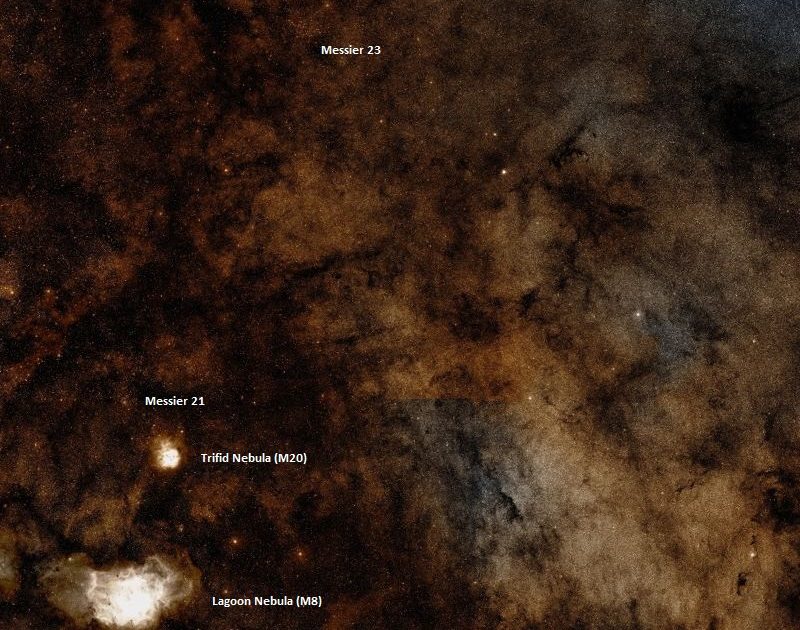Welcome back to Messier Monday! In our ongoing tribute to the great Tammy Plotner, we take a look at the Messier 23 open star cluster. Enjoy!
Back in the 18th century, famed French astronomer Charles Messier noted the presence of several "nebulous objects" in the night sky. Having originally mistaken them for comets, he began compiling a list of these objects so that other astronomers wouldn't make the same mistake. Consisting of 100 objects, the
Messier Catalog
has come to be viewed as a major milestone in the study of Deep Space Objects.
One of these objects is Messier 23 (aka. NGC 6494), a large open star cluster that is located in the constellation
Sagittarius
. Given its luminosity, it can be found quite easily in the rich star fields of the summer Milky Way using small telescopes and even binoculars.
Description:
Located some 2,150 light years (659 Parsecs) away from Earth, this vast cloud of 176 confirmed stars stretches across 15 to 20 light years of space. At an estimated 220 to 300 million years old, Messier 23 is on the "senior citizen" list of galactic open clusters in our galaxy. At this age, its hottest stars reach spectral type B9, and it even contains a few blue straggler candidates.
[caption id="attachment_130767" align="aligncenter" width="580"]
Mosaic image obtained as part of the Two Micron All Sky Survey (2MASS). Credit: UofM/IPAC/Caltech/NASA/NSF
[/caption]
Given that M23 has spent many centuries sweeping through the interstellar medium, astronomers have wondered how this would affect its metal content. Using UBV photometry, astronauts examined the metallicity of M23, and determined that it had no discernible effect. As
W.L. Sanders wrote
of the cluster in 1990:
At the same time, astronomers have discovered that some of M23's older stars - the red giants - are suffering mass loss. As
G. Barbaro (et al.)
of the Istituto di Fisica dell'Universita put it in 1969:
[caption id="attachment_130768" align="aligncenter" width="580"]
Close-up of the core of M23, showing some of its brightest member stars. Credit: Sharp/NOAO/AURA/NSF
[/caption]
However, the most recent studies show that we have to determine radial velocities before we can really associate red giants as being cluster members. J.C. Mermilliod of Laboratoire d'Astrophysique de l'Ecole wrote in his 2008 study, "
Red giants in open clusters
":
History of Observation:
This neat and tidy galactic star cluster was one of the original discoveries of Charles Messier. As he recorded of the cluster when first viewing it, which occurred on June 20th, 1764:
[caption id="attachment_130769" align="aligncenter" width="580"]
The M23 open star cluster, as it appears in the night sky (a patch of red), flanked by M8 (Lagoon), M16 (Eagle), M17 (Omega), M20 (Trifid) and other deep sky objects. Credit & Copyright: Fernando Cabrerizo/NASA
[/caption]
While William Herschel did not publish his observations of Messier's objects, he was still an avid observer. So of course, he had to look at this cluster, and wrote the following observations in his personal notes:
In July of 1835, Admiral Smyth would make an observation of Messier 23 and once again add his colorful remarks to the timeline:
Remember when observing Messier 23 that it won't slap you in the face like many objects. Basically, it looks like a stellar scattering of freckles across the face of the sky when fully-resolved. It's actually one of those objects that's better to view with binoculars and low power telescopes.
Locating Messier 23:
M23 can be easily found with binoculars about a finger's width north and two finger widths west of Mu Sagittarii. Or, simply draw a mental line between the top star in the teapot lid (Lambda) and Xi Serpentis. You'll find a slight compression in the star field about halfway between these two stars that shows up as an open cluster with binoculars.
Using a finderscope, the object will appear nicely as a hazy spot. And for those using telescopes of any size, you'll need to use fairly low magnification to help set this cluster apart from the surrounding star field, and it will resolve well to almost all instruments.
And here are the quick facts on this object to help you get started:
- Object Name
-
Messier 23
- Alternative Designations
-
M23, NGC 6494
- Object Type
-
Open Star Cluster
- Constellation
-
Sagittarius
- Right Ascension
-
17 : 56.8 (h:m)
- Declination
-
-19 : 01 (deg:m)
- Distance
-
2.15 (kly)
- Visual Brightness
-
6.9 (mag)
- Apparent Dimension
-
27.0 (arc min)
We have written many interesting articles about Messier Objects here at Universe Today. Here's Tammy Plotner's
Introduction to the Messier Objects
, ,
M1 – The Crab Nebula
,
M8 – The Lagoon Nebula
, and David Dickison's articles on the
2013
and
2014
Messier Marathons.
Be to sure to check out our complete
Messier Catalog
. And for more information, check out the
SEDS Messier Database
.
Sources:
 Universe Today
Universe Today
